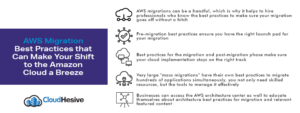AWS migration can be a painstaking task, but experienced AWS professionals have a playbook of best practices to make sure the entire process goes smoothly without disrupting your business.
Cloud migrations can take a toll on any organization’s internal resources. Making a move to the cloud involves certain intricacies, which means that the migration process is best handled by technicians with expertise in AWS migrations and the right know-how.
AWS Migration Partners are consultants who have the migration expertise and best practices to save the day. These best practices are based on their experience helping countless organizations through their cloud migration journey.
AWS migration best practices
AWS migration best practices can be broken out into three distinct phases: pre-migration, migration, and post-migration. At each stage, following the best practices will help ensure your migration is successful and your business gets the most benefit from it.
1. Pre-migration phase
Your migration really starts before any data is transferred. The pre-migration phase is essential for understanding what has to be migrated, how, and in what order:
- 1. Strategic leaders of the organizations have to build a clear vision regarding where the IT and business processes should overlap. This requires a solid vision of the wheres and whys of the technology and business process intersection. These priorities must be communicated to employees to ensure all the relevant people are onboard.
- 2. Cloud migrations can open the door to security risks if the right steps aren’t taken. Business leaders should plan who will need access to which information and what will be the security protocols.
- 3. Staff training before the actual migration is pivotal to ensure that there are no hiccups once the cloud transition is operational. Its vital to understand the system and application dependencies across the migration footprint
- 4. Make sure that the new business environment is aligned with overall business objectives. Put on your thinking cap about how certain business processes will function within the cloud and what fine-tuning will be needed to prevent future hassles or expenses.
- 5. Take stock of the IT assets you have and how much of your infrastructure is moving to the cloud. You should have the right discovery tools (such as the AWS Application Discovery Service) and always update your application inventory before the migration. This will help streamline migration planning and minimize the risk of missing a dependency. It will also help you gauge the success of your cloud migration.
- 6. You should be sure you have the right experts to help you navigate through your cloud migration and the post-migration phase. These experts should not only have in-depth technical knowledge and experience but also the right project management framework and agile methodology. You should know your cloud partner’s competencies and whether they will be able to implement your operational model and support it with managed services.
2. Migration phase
During the migration, these best practices will ensure you sail through with minimum business disruption:
- 1. Putting some quick wins on the table will help convince your business stakeholders to support your cloud vision with open arms. To do that, look to start smart and simple so the efficacy of the new cloud environment becomes visible at an early stage.
- 2. The agility potential of the cloud is realized by automating business processes. You should spend time evaluating all your business processes to identify the ones that can be automated.
- 3. Your shift to the cloud should have a transformational vibe. Look to fine-tune your internal processes so they are synchronized with the new cloud environment for optimal results.
- 4. Use fully managed services, such as Amazon RDS, AWS Directory Service, and Amazon DynamoDB, to handle everyday maintenance tasks. This will help you free up your workforce to perform more pressing tasks.
3. Post-migration phase
The following post-migrations best practices ensure you can extract maximum benefits from your new cloud setup as quickly as possible:
- 1. Monitoring everything in your new cloud environment will keep you informed about the performance of your applications. Continuous data insights can help you make better decisions about tradeoffs between costs and performance. You can use cloud-native tools such as AWS CloudWatch Logs to provide important application-level information. Use appropriate tagging to group and report on various AWS components and services.
- 2. AWS enterprise support such as the AWS Technical Account Managers (TAMs) and billing concierges can act as an extension of your virtual cloud team. Make sure to leverage the technical information and guidance that is on offer.
2 best practices for mass migrations involving hundreds of applications
If you are looking to migrate a large number of applications to the cloud, these two best practices are essential:
- 1. Build a well-documented and vigorous migration strategy that includes specialized teams, processes, and tools focused on increasing the velocity of your migration. This mechanism should include protocols to prevent delays that may be caused by myriad reasons.
- 2. Your migration mechanism needs a project management office that coordinates all the cloud-based activities. You should also look to have a Cloud center of excellence that can act as an advisory body and anchor the technical aspects of your cloud transformation.
- 3. All the applications should be tested and validated under a set of predetermined protocols in the new cloud environment.
AWS Architecture Center
The AWS Architecture Center is a library of technical resources that is continuously growing. Every day, experts place more and more information in the center, which means that you will find updated cloud-focused best practices for just about any contingency in this library.
The center offers tools such as AWS Well-Architected and other featured content that can give you immense knowledge about how to go about your cloud migration.
Developers can also access AWS Solutions and AWS Whitepapers and Guides to hone their AWS skills with the vast information made available.
CloudHesive AWS managed services
CloudHesive is an AWS Premier Partner with Managed Services and Managed Security Services’ Competencies.. We offer support in key areas such as planning, designing, building, migrating, running, operating, securing and optimizing your cloud-related activities.
Contact us today for a thorough consultation regarding your cloud-based business transformation.



